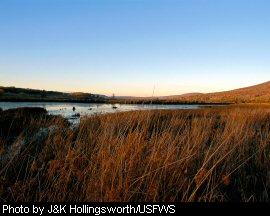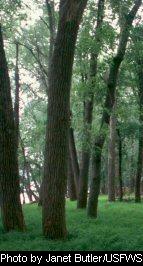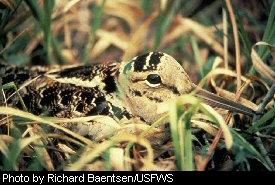

|
A Century of Conserving Wildlife: National Wildlife Refuges in West Virginia By Ed Henry
Inspired by a German immigrant, Paul Kroegel , many prominent citizens rallied around this five-acre island to spearhead the protection of these important wildlife habitats. Soon, guided by President Roosevelt's leadership and a growing conservation movement, wildlife protection became a national interest. On March 14, 1903, President Roosevelt solidified a commitment to preserving our nation's wildlife heritage, and set the groundwork to help save many species from pending extinction, as he established Pelican Island National Wildlife Refuge. The model of national wildlife refuges gained popularity, and by the time Roosevelt had left office in 1909, he had created 50 refuges. Today, this nationwide system includes lands in every state, including two refuges in West Virginia. In 1990, the Service established the Ohio River Islands National Wildlife Refuge, the first refuge in West Virginia. Four years later, the Service established Canaan Valley NWR, the system's 500 th refuge. On March 14, 2003, these refuges joined the rest of the U.S. Fish and Wildlife Service in celebrating a century of conservation. Ohio River Islands NWRThe broad Ohio River, once wild and strong, now bears the freight of industry along its controlled waters. Forming West Virginia's western border, the river is both a barrier and a boon to people and wildlife. Although dams now subdue the power and fury of its once free-flowing waters, the Ohio River retains some of its original character. The river itself, the islands and the riverbanks provide high quality habitat for many hundreds of species. Scattered throughout the Ohio's wandering course are a series of islands. Covered in forest and meadow, these havens rise from the river's broad stream. In West Virginia, 17 of these islands and three mainland tracts compose most of the Ohio River Islands National Wildlife Refuge. The refuge also stretches into Kentucky and Ohio.
The refuge harbors many other less visible species as well. Nearly 40 species of freshwater mussels, including the endangered pink mucket pearly and fanshell mussels, live in refuge waters. Frogs, toads, turtles, salamanders, insects, mice and chipmunks also live on refuge lands. In total, the refuge protects habitats for hundreds of species for current and future generations. “The refuge welcomes visitors – yet the refuge is a place where wildlife comes first for the public's benefit,” said Rhine. The refuge offers many opportunities to observe wildlife including beaver, muskrat, white-tailed deer, great blue herons, green heron, warblers, waterfowl and turtles. Wildlife photography is encouraged. “We have an observation blind along our nature trail, so visitors have a better chance of seeing and photographing wildlife. When people photograph wildlife, they can't help but learn more about the species – where it lives, where it feeds, how it moves, and what it does,” said Rhine. Bird watching is a major pastime, and the refuge is one of the best places in the Ohio Valley to see many grassland, forestland and water bird species. Since many birds use the refuge as a stopover during their migrations, some are only present for a short time each year. With so much of the region cultivated or developed, the refuge hosts prime habitat for many bird species. As a result, the refuge is an important destination for birds and birdwatchers. Waterfowl, songbirds and raptors all use the refuge. The refuge is a premier spot for herons and harbors a number of great blue heron rookeries. Many of the islands are open to recreational opportunities, such as hunting, fishing and birdwatching , whenever they fit with the refuge's purpose. “Hunting is a priority public use on the refuge – it is a valuable management tool and good for the local economy. People from as far as way as Pittsburgh and Louisville come here to hunt deer, waterfowl, rabbits and squirrel,” said Rhine. Although altered by dams, pollution and use, the Ohio River still supports a healthy fish community. “Some of the best fishing on the Ohio River is here,” adds Rhine. Fishing is a popular sport, and one that can involve entire families. More than 50 fish species live in refuge waters, including smallmouth and largemouth bass, channel catfish and sauger . Many nongame fish also call this stretch of river home. The fish also provide food for many of the refuge's birds. Canaan Valley NWRCanaan (pronounced kuh -NANE) Valley is the highest valley of its size in the eastern United States. Surrounded by mountains, some up to 4,000 feet high, the area has a distinct scenic character and climate. The refuge is among the most scenic spots in the eastern United States. The valley floor averages about 3,200 feet above sea level, and is cooler and wetter than other nearby valleys. The refuge includes about half the valley floor and surrounding uplands, helping to preserve the valley's unique plant and animal communities. Among these important habitats is one of the nation's largest shrub swamps and the fourth largest bog in the eastern United States. “Canaan Valley NWR offers outstanding opportunities for the public to see plants and wildlife typical of northern forests and wetlands,” said recent Refuge Manager During the last ice age, northern plants and animals migrated to West Virginia's mountains and valleys to remain ahead of the advancing continental ice sheet. When warmer conditions returned, about 12,000 years ago, most species returned north as they were unable to survive West Virginia's warmer climates. Some species (109 found on the refuge are typical of Maine or Canada) found new homes in higher elevations such as Canaan Valley. The refuge protects this island of boreal (northern) habitat and diversity among the more moderate climes of the central Appalachians. One bird using Canaan Valley's unique habitat is the woodcock. “Known for their spring flight display to attract females and establish territories, woodcocks are well suited to the refuge's cool, moist habitats,” said Shryer . “Canaan Valley also has habitat for federally threatened and endangered species such as the Cheat Mountain salamander and northern flying squirrel.” Anglers holding a state fishing license can fish in the refuge's rivers and ponds. Hunting is another popular pastime. Most game species can be hunted on the refuge. Hunters must possess a valid state hunting license, a refuge hunt permit and a photo identification. Along with hunting and fishing, the refuge offers many opportunities for recreation and learning. Outdoor recreation enthusiasts and passing tourists can explore the refuge's natural and cultural story through videos, exhibits and hands-on experiences at the Visitor Center. The refuge Friends group, The Friends of the 500th, frequently staffs the information station, operates the bookstore and provides support for the refuge and its activities. The Friends of the 500th also offer walks and talks on the refuge and its environment. Canaan Valley's trails offer wildlife watching, nature photography, environmental education and interaction with the natural world. Some trails skirt wetlands and have open views of the valley, while others move through woodlands. Since the trails are primarily for wildlife watching, most are open only to foot traffic. Wildlife and landscape photographers can have a field day on the trails. With the surrounding mountains rising more than 1,400 feet above the valley floor, Canaan has many spectacular backdrops. The diverse plant and animal communities provide numerous opportunities for telephoto and close-up photography. The wide, surging waters of the Ohio River and the windy waves of grasses in Canaan Valley both provide oceans of opportunities for outdoor and wildlife-related recreation. West Virginia's rural character remains a key ingredient in the abundant, healthy fish and wildlife populations found throughout the state. Together these two national wildlife refuges provide glimpses of the state's highest and lowest elevation wetland habitats, and provide high-quality experiences for the casual and dedicated outdoors-person. As the National Wildlife Refuge System turns 100 years old, take a moment to reflect on or visit one of these special places. To learn more about Canaan Valley and Ohio River National Wildlife refuges, visit our website at http//refuges.fws.gov or call 1-800-344-WILD. Ed Henry is a Public Affairs Specialist with the U.S. Fish and Wildlife Service. |
 In 1903, Pelican Island, Florida, became the focus of conservationists and feather hunters. Bird plumage was in high demand for women's hats, driving a market that led to the death of millions of birds. After years of exploitation for their plumage, many of our nation's most magnificent birds were nearing extinction. For brown pelicans, Pelican Island was the last breeding ground along Florida's east coast. On this small island, conservationists, led by President Theodore Roosevelt, made a stand.
In 1903, Pelican Island, Florida, became the focus of conservationists and feather hunters. Bird plumage was in high demand for women's hats, driving a market that led to the death of millions of birds. After years of exploitation for their plumage, many of our nation's most magnificent birds were nearing extinction. For brown pelicans, Pelican Island was the last breeding ground along Florida's east coast. On this small island, conservationists, led by President Theodore Roosevelt, made a stand.  Spread over 362 miles of river, the refuge is a rest stop for more than 200 species of birds. “The refuge's purpose is to safeguard a future for wildlife along the river,” said refuge manager Dean Rhine. “Refuge staff work to protect, restore and enhance habitat for wildlife native to the river's floodplain. Many of our birds spend only part of the year here,” said Rhine. “Bald eagles like to winter along the river and many ospreys spend the warmer seasons on or near the refuge.”
Spread over 362 miles of river, the refuge is a rest stop for more than 200 species of birds. “The refuge's purpose is to safeguard a future for wildlife along the river,” said refuge manager Dean Rhine. “Refuge staff work to protect, restore and enhance habitat for wildlife native to the river's floodplain. Many of our birds spend only part of the year here,” said Rhine. “Bald eagles like to winter along the river and many ospreys spend the warmer seasons on or near the refuge.”  Jeff Shryer . “Our climate and habitats are closer to those of Canada than surrounding areas in West Virginia. Together, the topography and climate produce a unique and diverse place for mammals and migratory birds. In the Valley, we protect more than 9,000 acres of wetlands and 25,000 acres of uplands. In total, scientists believe that more than 280 species of vertebrates live on the refuge.”
Jeff Shryer . “Our climate and habitats are closer to those of Canada than surrounding areas in West Virginia. Together, the topography and climate produce a unique and diverse place for mammals and migratory birds. In the Valley, we protect more than 9,000 acres of wetlands and 25,000 acres of uplands. In total, scientists believe that more than 280 species of vertebrates live on the refuge.”